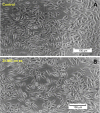Biocompatibility evaluation of sputtered zirconium-based thin film metallic glass-coated steels
- PMID: 26491304
- PMCID: PMC4599602
- DOI: 10.2147/IJN.S79977
Biocompatibility evaluation of sputtered zirconium-based thin film metallic glass-coated steels
Abstract
Thin film metallic glasses comprised of Zr48Cu36Al8Ag8 (at.%) of approximately 1.5 μm and 3 μm in thickness were prepared using magnetron sputtering onto medical grade 316L stainless steel. Their structural and mechanical properties, in vitro corrosion, and antimicrobial activity were analyzed. The amorphous thin film metallic glasses consisted of a single glassy phase, with an absence of any detectable peaks corresponding to crystalline phases. Elemental composition close to the target alloy was noted from EDAX analysis of the thin film. The surface morphology of the film showed a smooth surface on scanning electron microscopy and atomic force microscopy. In vitro electrochemical corrosion studies indicated that the zirconium-based metallic glass could withstand body fluid, showing superior resistance to corrosion and electrochemical stability. Interactions between the coated surface and bacteria were investigated by agar diffusion, solution suspension, and wet interfacial contact methods. The results indicated a clear zone of inhibition against the growth of microorganisms such as Escherichia coli and Staphylococcus aureus, confirming the antimicrobial activity of the thin film metallic glasses. Cytotoxicity studies using L929 fibroblast cells showed these coatings to be noncytotoxic in nature.
Keywords: antimicrobial activity; biocompatibility; corrosion; sputtering; thin film metallic glasses.
Figures













Similar articles
-
Review on Biocompatibility and Prospect Biomedical Applications of Novel Functional Metallic Glasses.J Funct Biomater. 2022 Nov 16;13(4):245. doi: 10.3390/jfb13040245. J Funct Biomater. 2022. PMID: 36412886 Free PMC article. Review.
-
In vitro corrosion and biocompatibility screening of sputtered Ti40Cu36Pd14Zr10 thin film metallic glasses on steels.Mater Sci Eng C Mater Biol Appl. 2015 Feb;47:48-56. doi: 10.1016/j.msec.2014.11.013. Epub 2014 Nov 8. Mater Sci Eng C Mater Biol Appl. 2015. PMID: 25492171
-
Promising antimicrobial capability of thin film metallic glasses.Mater Sci Eng C Mater Biol Appl. 2014 Mar 1;36:221-5. doi: 10.1016/j.msec.2013.12.015. Epub 2013 Dec 15. Mater Sci Eng C Mater Biol Appl. 2014. PMID: 24433907
-
Cytocompatibility assessment of Ti-Nb-Zr-Si thin film metallic glasses with enhanced osteoblast differentiation for biomedical applications.Colloids Surf B Biointerfaces. 2019 Jan 1;173:109-120. doi: 10.1016/j.colsurfb.2018.09.041. Epub 2018 Sep 20. Colloids Surf B Biointerfaces. 2019. PMID: 30273871
-
Surface functionalized bioceramics coated on metallic implants for biomedical and anticorrosion performance - a review.J Mater Chem B. 2021 Dec 1;9(46):9433-9460. doi: 10.1039/d1tb01301g. J Mater Chem B. 2021. PMID: 34755756 Review.
Cited by
-
Antibacterial metals and alloys for potential biomedical implants.Bioact Mater. 2021 Feb 8;6(8):2569-2612. doi: 10.1016/j.bioactmat.2021.01.030. eCollection 2021 Aug. Bioact Mater. 2021. PMID: 33615045 Free PMC article. Review.
-
Review on Biocompatibility and Prospect Biomedical Applications of Novel Functional Metallic Glasses.J Funct Biomater. 2022 Nov 16;13(4):245. doi: 10.3390/jfb13040245. J Funct Biomater. 2022. PMID: 36412886 Free PMC article. Review.
-
Preclinical studies of non-stick thin film metallic glass-coated syringe needles.Sci Rep. 2020 Nov 20;10(1):20313. doi: 10.1038/s41598-020-77008-y. Sci Rep. 2020. PMID: 33219243 Free PMC article.
References
-
- Huang CH, Huang JC, Li JB, Jang JSC. Simulated body fluid electrochemical response of Zr-based metallic glasses with different degrees of crystallization. Mater Sci Eng C. 2013;33:4183–4187. - PubMed
-
- Lin CH, Huang CH, Chuang JF, Huang JC, Jang JS, Chen CH. Rapid screening of potential metallic glasses for biomedical applications. Mater Sci Eng C. 2013;33:4520–4526. - PubMed
-
- Chen M. A brief overview of bulk metallic glasses. NPG Asia Materials. 2011;3:82–90.
-
- Inoue A, Zhang W, Zhang T, Kurosaka K. High-strength Cu-based bulk glassy alloys in Cu-Zr-Ti and Cu-Hf-Ti ternary systems. Acta Mater. 2001;49:2645–2652.
-
- Jiang QK, Wang XD, Nie XP, et al. Zr-(Cu,Ag)-Al bulk metallic glasses. Acta Mater. 2008;56:1785–1796.
Publication types
MeSH terms
Substances
LinkOut - more resources
Full Text Sources

